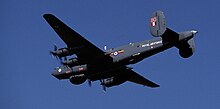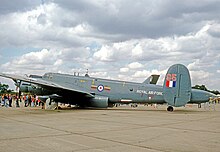
Royal Air Force Lossiemouth or more commonly RAF Lossiemouth is a military airfield located on the western edge of the town of Lossiemouth in Moray, north-east Scotland.

Number 23 Squadron is a squadron of the Royal Air Force responsible for 'day-to-day space operations', having been reformed in January 2021, as the first "space squadron". Up until its disbandment in October 2009, it operated the Boeing Sentry AEW1 Airborne Warning And Control System (AWACS) aircraft from RAF Waddington, Lincolnshire.
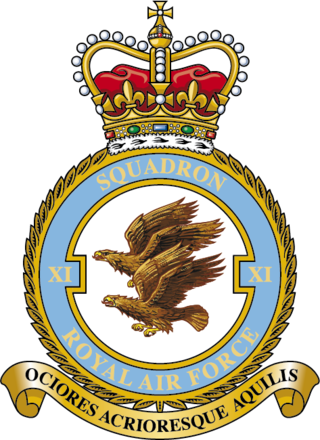
No. 11 or XI Squadron, is "the world's oldest, dedicated fighter unit" and continues the traditions established by the similarly numbered Royal Flying Corps squadron, established in 1915. After a history of equipment with numerous different aircraft types, the squadron most recently operated the Tornado F3 until 2005 when it was disbanded. It was reactivated in 2006 to operate the Typhoon F2, receiving its first aircraft on 9 October 2006.

Number 6 Squadron of the Royal Air Force operates the Eurofighter Typhoon FGR.4 at RAF Lossiemouth. It was previously equipped with the SEPECAT Jaguar GR.3 in the close air support and tactical reconnaissance roles, and was posted to RAF Coltishall, Norfolk until April 2006, moving to RAF Coningsby until disbanding for the first time in its history on 31 May 2007. The squadron officially reformed as a Typhoon squadron on 6 September 2010. No. 6 Squadron is unique in having two Royal standards, having been awarded its second one by King Abdullah I of Jordan in October 1950 due to its long period of service in the Middle East.

The de Havilland DH 112 Venom is a British post-war single-engined jet aircraft developed and manufactured by the de Havilland Aircraft Company. Much of its design was derived from the de Havilland Vampire, the firm's first jet-powered combat aircraft; it was initially referred to as the Vampire FB 8 prior to the adoption of the Venom name.

Number 4 Squadron, normally written as No. IV Squadron, is a squadron of the Royal Air Force. Since November 2011, it has operated the BAE Hawk T2 from RAF Valley, Anglesey, Wales. The squadron provides weapons and tactics training for student pilots after they have completed their conversion to jet aircraft with No. XXV(F) Squadron. Between 1970 and January 2011, No. IV Squadron operated various marks of the Hawker Siddeley Harrier and British Aerospace Harrier II.
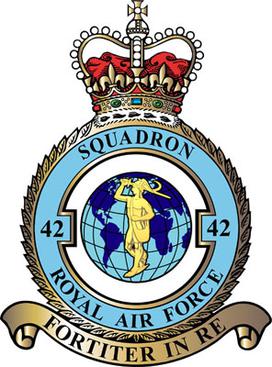
Number 42 Squadron, also known as No. 42 Squadron, is a squadron of the Royal Air Force. It reformed at RAF Lossiemouth on 21 September 2023 as the Operational Conversion Unit for both the Boeing Poseidon MRA1 and Boeing Wedgetail AEW1.

No. 14 Squadron of the Royal Air Force currently operates the Beechcraft Shadow R1 in the Intelligence, surveillance, target acquisition, and reconnaissance (ISTAR) role from RAF Waddington.
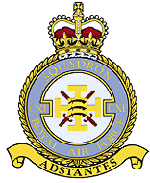
Number 111 (Fighter) Squadron, also known as No. CXI (F) Squadron and nicknamed Treble One, was a squadron of the Royal Air Force. It was formed in 1917 in the Middle East as No. 111 Squadron of the Royal Flying Corps during the reorganisation of the Egyptian Expeditionary Force after General Edmund Allenby took command during the Sinai and Palestine Campaign. The squadron remained in the Middle East after the end of the First World War until 1920 when it was renumbered as No. 14 Squadron.
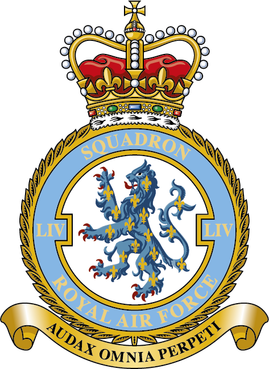
Number 54 Squadron is a squadron of the Royal Air Force based at RAF Waddington, Lincolnshire. On 1 September 2005, it took on the role of Intelligence, Surveillance and Reconnaissance (ISR) Operational Conversion Unit, and is now the Advanced Air ISTAR Academy, responsible for training all RAF crews assigned to the MQ-9A Reaper, Protector RG1 (MQ-9B), Shadow R1/R2, RC-135W Rivet Joint and Poseidon MRA1. It also controls the RAF ISR Warfare School (ISRWS) who run the Qualified Weapons Instructor Intelligence, Surveillance and Reconnaissance and QWI Reaper Courses.
Royal Air Force Bircham Newton or more simply RAF Bircham Newton is a former Royal Air Force station located 2.1 miles (3.4 km) south east of Docking, Norfolk and 13.4 miles (21.6 km) north east of King's Lynn, Norfolk, England.
No. 90 Squadron RAF is a squadron of the Royal Air Force.
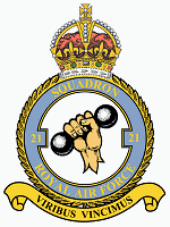
No. 21 Squadron of the Royal Air Force was formed in 1915 and was disbanded for the last time in 1979.

No. 26 Squadron of the Royal Air Force was formed in 1915 and was disbanded for the last time in 1976.
No. 52 Squadron was a Royal Air Force squadron that saw service in both World War I and World War II.
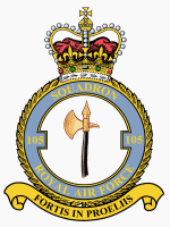
No. 105 Squadron was a flying squadron of the Royal Air Force, active for three periods between 1917 and 1969. It was originally established during the First World War as a squadron of the Royal Flying Corps and disbanded after the war. Reactivated shortly before the Second World War, it was inactive again after the conflict. During its second existence it was a bomber unit and had the distinction to be the first to operate the de Havilland Mosquito light bomber. During the 1960s it was reactivated again for six years to provide transport support for the British Army in the Aden Protectorate and the Far East.

No. 223 Squadron RAF was a squadron of the Royal Air Force. Originally formed as part of the Royal Naval Air Service (RNAS), the Squadron flew in both World Wars.
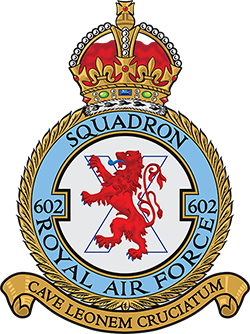
602 Squadron is a Royal Auxiliary Air Force squadron. Originally formed in 1925 as a light bomber squadron, its role changed in 1938 to army co-operation and in 1939 to that of a fighter squadron.
No. 248 Squadron was a squadron of the Royal Air Force, active immediately after World War I, and again during World War II.
No. 114 Squadron was a squadron of the British Royal Air Force. It was first formed in India during the First World War, serving as a light bomber squadron during the Second World War and as a transport squadron post-war. It was last disbanded in 1971.


